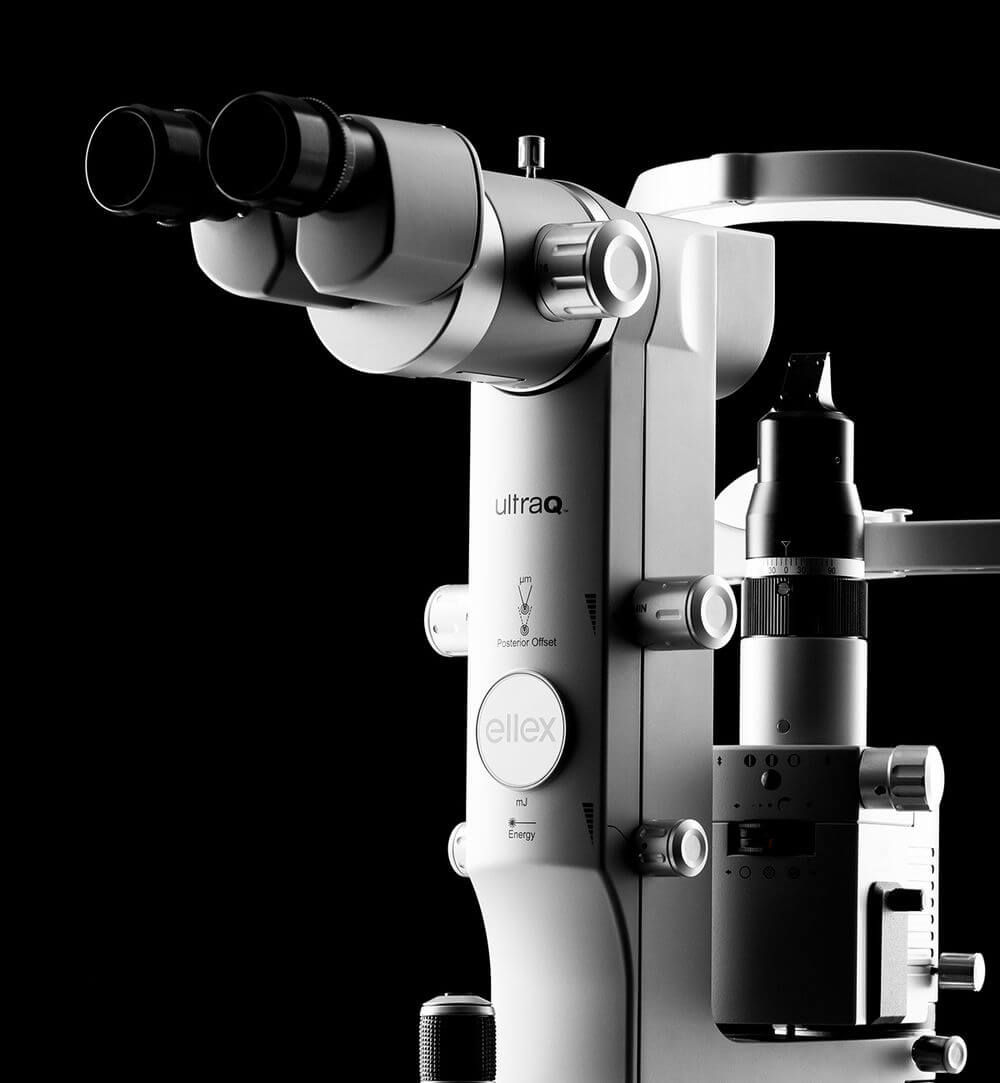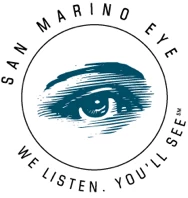Modern Laser Floater Treatment Using The Ultra Q Reflex™
Dr. David Richardson has recently acquired the Ultra Q Reflex™.
Touted as the “Floater-Treatment Laser,” this advanced, FDA-approved technology can vaporize floaters in just a few minutes—safely & painlessly!


Don’t let eye floaters cloud your vision.
Your floaters can be treated without surgery.
This in-office procedure is called “Laser Floater Treatment (LFT)” or Laser Vitreolysis.
What is Laser Floater Treatment
Laser Floater Treatment or Laser Vitreolysis is a minimally invasive, in-office procedure that can provide a much-needed relief from floaters. [Read…What Are Eye Floaters→]
It involves the application of nanosecond pulses of laser light to evaporate the vitreous opacities and to sever the vitreous strands. During this process, the floater’s collagen and hyaluronic molecules are converted into a gas. The result is that the floater is removed and/or reduced in size.
The goal of laser vitreolysis is to achieve a “functional improvement.” That is, to allow you to resume eye normal day-to-day activities without the hindrance of floaters.
Laser Vitreolysis is performed as an outpatient procedure in your ophthalmologist’s office; you do not need to stay overnight in a hospital. The procedure typically takes from 10-45 minutes to perform, and you may require more than one treatment session to achieve a satisfactory result.
Modern Laser Floater Treatment Using
Ultra Q Reflex™ at San Marino Eye
Yag Laser Vitreolysis. The safer, non-invasive treatment.
Dr. David Richardson uses Ellex Ultra Q Reflex™, an FDA approved advanced technology optimized for Laser Floater Treatment.
- Highly effective treatment for floaters (~90% success rate!)
- Pain-free, non-invasive in-office procedure
- Low-risk profile. Safer than vitrectomy surgery and early laser floater surgery
- An in-office procedure that typically takes 10-45 minutes treatment
- Marked improvement only after 1-3 sessions!
- No restrictions on activities post procedure
Ellex Laser Floater Treatment (LFT)
Watch how LFT (Laser Floater Treatment) with Reflex™ Technology can safely and effectively alleviate the debilitating effects of persistent floaters. Reflex™ Technology from Ellex® allows optimal visualization, showing floaters in necessary spatial context for safer treatment. The efficiency of the laser ensures vaporization of the molecules that make up the floater, converting them into a gas which is absorbed into the eye.
Laser Floater Treatment Frequently Asked Questions
Who will benefit from Laser Floater Treatment?
While a thorough eye examination is still the best way to determine your eligibility for LFT, some primary conditions will most likely make you the right candidate:
- If your floater symptoms develop very quickly
- If your floaters are large with a soft border, situated away from the retina.
- If your floaters materially impact your quality of life
- If you’ve had floaters for at least 3 months
What happens during the procedure?
Before Laser Floater Treatment, you will complete a questionnaire to help your eye doctor asses the type and severity of your floaters. Accurate position and appearance of your floaters will then be acquired (and shown to you) using technologically advanced Imaging equipment.
If you are a candidate, a few drops are placed in the eye to dilate and anesthetize the eye. You will sit comfortably behind a unique laser/microscope that is specifically designed for this procedure.
During the procedure, you will feel very little or no sensation on your eye, but you will hear the sound of the laser working. You will likely observe small, dark specks/shadows – signaling that the floaters are being evaporated into tiny gas bubbles. These gas bubbles quickly dissolve and resorb into the vitreous.
The procedure typically takes from 10-45 minutes to perform.
What can I expect after treatment?
Once the treatment is complete, your ophthalmologist may treat your eyes with anti-inflammatory drops.
You will be asked to stay 20-30 minutes in the office for an eye pressure check, and then you can go after that.
You may observe small, dark specks in your lower field of vision immediately following treatment, but these tiny gas bubbles will quickly dissolve. It is also important to note that some patients may experience mild discomfort, redness, or temporarily blurred vision directly following treatment. However, you will be able to return to normal day-to-day activities within a few hours.
Most patients will need to undergo two treatment sessions, sometimes three, to achieve a satisfactory result.
Any complications and side effects?
Reported side effects and complications associated with LFT are rare. Common risks may include corneal abrasion and intraocular pressure (IOP) spike, which may be resolved by simple treatment interventions.
You should call if there are any significant visual changes, eye pain, or anything more than mild eye irritation that would not respond to cool compresses or artificial tears.
Who may NOT benefit from Laser Floater Treatment?
Some eye conditions will most likely NOT make you the right candidate. However, only a thorough eye examination can produce a final diagnosis:
- If you are experiencing flashing lights in your vision
- If you are suffering from ocular inflammation
- If you have retinal conditions such as tears, holes or hemorrhages
- If your floaters are situated too near the retina and lens.
Will vision be entirely floaters-free after therapy, and how long does it take to see improvement?
In treated eyes, it is common to see improvement, but because the vitreous gel is being modified rather than being removed, some floaters may persist despite perfect treatment. Generally, if most of the central floaters are broken up, the brain can adapt to any remaining small floaters.
What kinds of things should I be concerned about if I have floaters treatment (laser versus vitrectomy)?
When a Vitrectomy is performed, the gel of the eye is removed surgically. This is done by inserting small tools into the eye under sterile conditions in an operating room. With Laser Vitreolysis, a light source is used to apply energy directly to floaters to vaporize them and move them out of the way of the central visual part of the eye. Both treatments carry risks. However, the chances of cataract formation, infection, and bleeding (also rare) are minimal with Vitreolysis because no physical tool enters the eye.
What kind of care will there be after laser floater treatment, and might I need another session?
You will be able to continue taking your usual oral or topical medications after laser. You will also be able to resume normal activities (driving, etc.) following laser treatment. However, avoid rubbing your eye. Makeup and showering, etc. are fine.
The eye may be mildly irritable (red, feeling dry, mildly scratchy) afterward because a contact lens is used to steady the eye and focus on the floaters during treatment.
Depending on the type and location of the floaters, more than one treatment session may be required.
There is always a 4-5 week follow-up clinical examination after laser where the eye is dilated, and an IOP checked. However, if your eye pressure is elevated on day one after treatment, then a recheck will be done sooner.
What Some of The Top Ophthalmologists Are Saying
We have been programmed to minimize the impact of floaters on patient’s daily lives because we had no viable solution. Today we have a solution.
Modern laser floater treatment is a different procedure. It is not the same procedure as in past years. Earlier attempts at treating floaters were not always positive, because the technology was not optimized for the procedure.
Laser vitreolysis has become a positive addition to my busy practice. The treatment is safe, effective, and painless with a very low complication rate…the procedure has enabled scores of patients to achieve functional improvements in their vision and greatly improved their quality of life in the process.
For over two decades I’ve shared my patients’ frustration that nothing could be done about their annoying and often activity limiting floaters. Time helped some, but for those with persistent bothersome floaters, the risk and high cost of vitrectomy was often just too great to consider. The older laser vitreolysis techniques were difficult to perform and had limited evidence of benefit.
Over the last few years, evidence has been growing that Laser Floater Treatment using the Ultra-Q Reflex laser is superior in both safety and effectiveness over the older available technology. By 2019 I was convinced that Laser Floater Treatment was indeed a low-risk method of reducing floater symptoms. What a relief it is to now be able to offer a real solution to my patients with visually bothersome floaters!
recognized as one of the most highly skilled ophthalmologists in the US
Meet Dr. David Richardson

David Richardson, MD
Medical Director, San Marino Eye
Patient-Focused Ophthalmologist specializing in the treatment of cataract and glaucoma. Dr. Richardson is recognized as one of the top cataract and glaucoma surgeons in the US and is among an elite group of glaucoma surgeons in the country performing the highly specialized canaloplasty procedure. Morever, Dr. Richardson is one of only a few surgeons in the greater Los Angeles area that performs MicroPulse P3™ "Cyclophotocoagulation" (MP3) glaucoma laser surgery. Dr. Richardson graduated Magna Cum Laude from the University of Southern California and earned his Medical Degree from Harvard Medical School. He completed his ophthalmology residency at the LAC+USC Medical Center/ Doheny Eye Institute.
